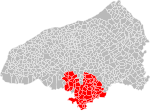Roman Catholic Archdiocese of Rouen
Archbishops of RouenBishops of RouenRoman Catholic dioceses in FranceRoman Catholic primatesRouen

The Archdiocese of Rouen (Latin: Archidioecesis Rothomagensis; French: Archidiocèse de Rouen) is a Latin Church archdiocese of the Catholic Church in France. As one of the fifteen Archbishops of France, the Archbishop of Rouen's ecclesiastical province comprises the greater part of Normandy. The Archbishop of Rouen is currently Dominique Lebrun.
Excerpt from the Wikipedia article Roman Catholic Archdiocese of Rouen (License: CC BY-SA 3.0, Authors, Images).Roman Catholic Archdiocese of Rouen
Place de la Cathédrale, Rouen Quartier Vieux-Marché Cathédrale
Geographical coordinates (GPS) Address Nearby Places Show on map
Geographical coordinates (GPS)
| Latitude | Longitude |
|---|---|
| N 49.4402 ° | E 1.09509 ° |
Address
Cathédrale Notre-Dame
Place de la Cathédrale
76000 Rouen, Quartier Vieux-Marché Cathédrale
Normandy, France
Open on Google Maps









